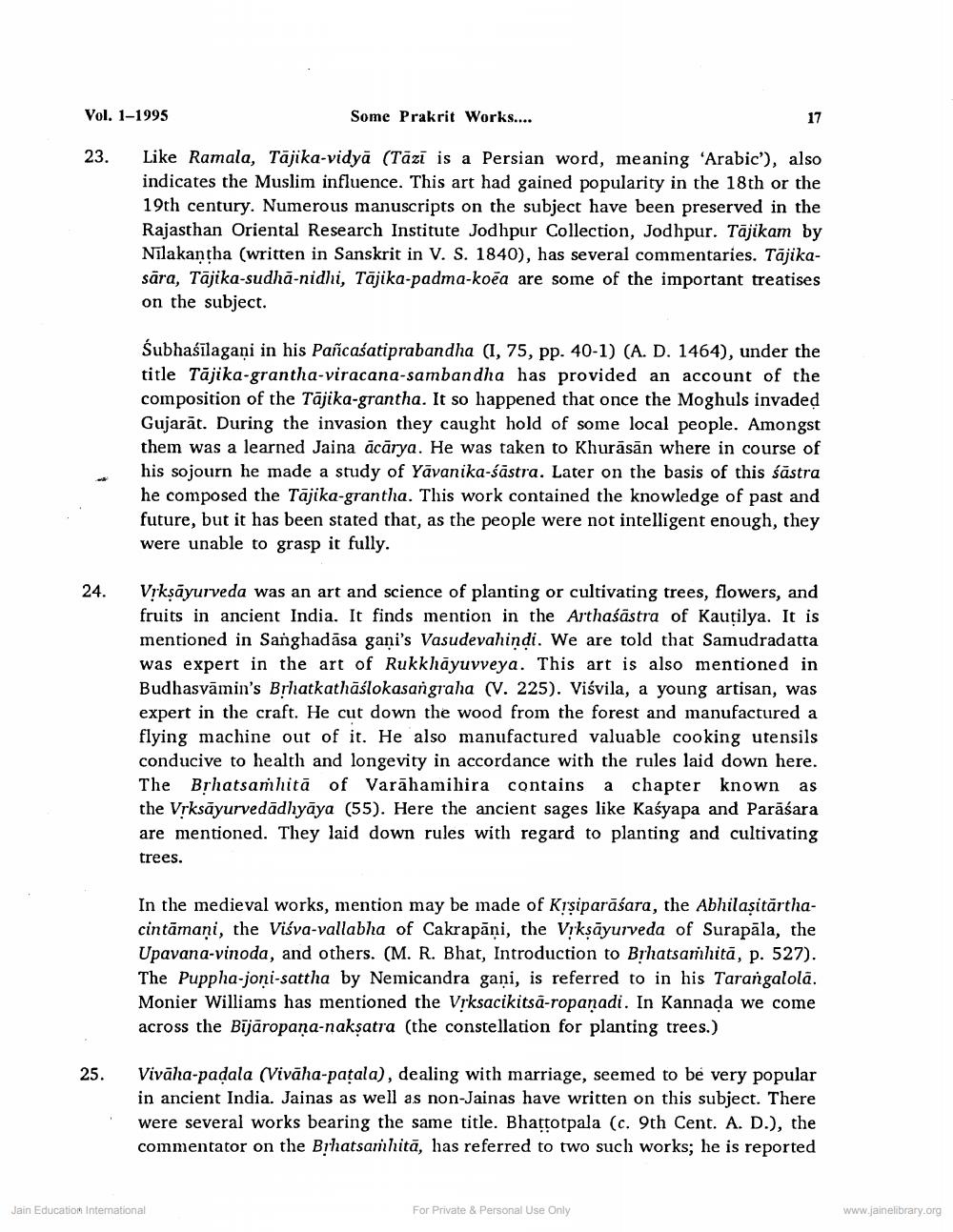________________
Vol. 1-1995
Some Prakrit Works....
23.
Like Ramala, Tājika-vidyā (Tāzī is a Persian word, meaning 'Arabic), also indicates the Muslim influence. This art had gained popularity in the 18th or the 19th century. Numerous manuscripts on the subject have been preserved in the Rajasthan Oriental Research Institute Jodhpur Collection, Jodhpur. Tājikam by Nilakantha (written in Sanskrit in V. S. 1840), has several commentaries. Tājikasāra, Tajika-sudha-nidhi, Tajika-padma-koēa are some of the important treatises on the subject.
śubhaśīlagani in his Pañcaśatiprabandha (I, 75, pp. 40-1) (A. D. 1464), under the title Tājika-grantha-viracana-sambandha has provided an account of the composition of the Tājika-grantha. It so happened that once the Moghuls invaded Gujarāt. During the invasion they caught hold of some local people. Amongst them was a learned Jaina ācārya. He was taken to Khurāsān where in course of his sojourn he made a study of Yavanika-śāstra. Later on the basis of this śāstra he composed the Tajika-grantha. This work contained the knowledge of past and future, but it has been stated that, as the people were not intelligent enough, they were unable to grasp it fully.
24.
Vyksāyurveda was an art and science of planting or cultivating trees, flowers, and fruits in ancient India. It finds mention in the Arthaśāstra of Kautilya. It is mentioned in Sanghadāsa gani's Vasudevahindi. We are told that Samudradatta was expert in the art of Rukkhāyuvveya. This art is also mentioned in Budhasvāmin's Brhatkathāślokasangraha (V. 225). Viśvila, a young artisan, was expert in the craft. He cut down the wood from the forest and manufactured a flying machine out of it. He also manufactured valuable cooking utensils conducive to health and longevity in accordance with the rules laid down here. The Brhatsamhitā of Varāhamihira contains a chapter known as the Vrksāyurvedadhyāya (55). Here the ancient sages like Kaśyapa and Parāśara are mentioned. They laid down rules with regard to planting and cultivating trees.
In the medieval works, mention may be made of Krsiparāśara, the Abhilasitarthacintamani, the Viśva-vallabha of Cakrapāni, the Viksāyurveda of Surapāla, the Upavana-vinoda, and others. (M. R. Bhat, Introduction to Brhatsamhitā, p. 527). The Puppha-joni-sattha by Nemicandra gani, is referred to in his Tarangalolā. Monier Williams has mentioned the Vrksacikitsa-ropanadi. In Kannada we come across the Bījāropana-nakṣatra (the constellation for planting trees.)
Vivāha-padala (Vivāha-patala), dealing with marriage, seemed to be very popular in ancient India. Jainas as well as non-Jainas have written on this subject. There were several works bearing the same title. Bhattotpala (c. 9th Cent. A. D.), the commentator on the Brhatsamhitā, has referred to two such works; he is reported
Jain Education Intemational
For Private & Personal Use Only
www.jainelibrary.org




